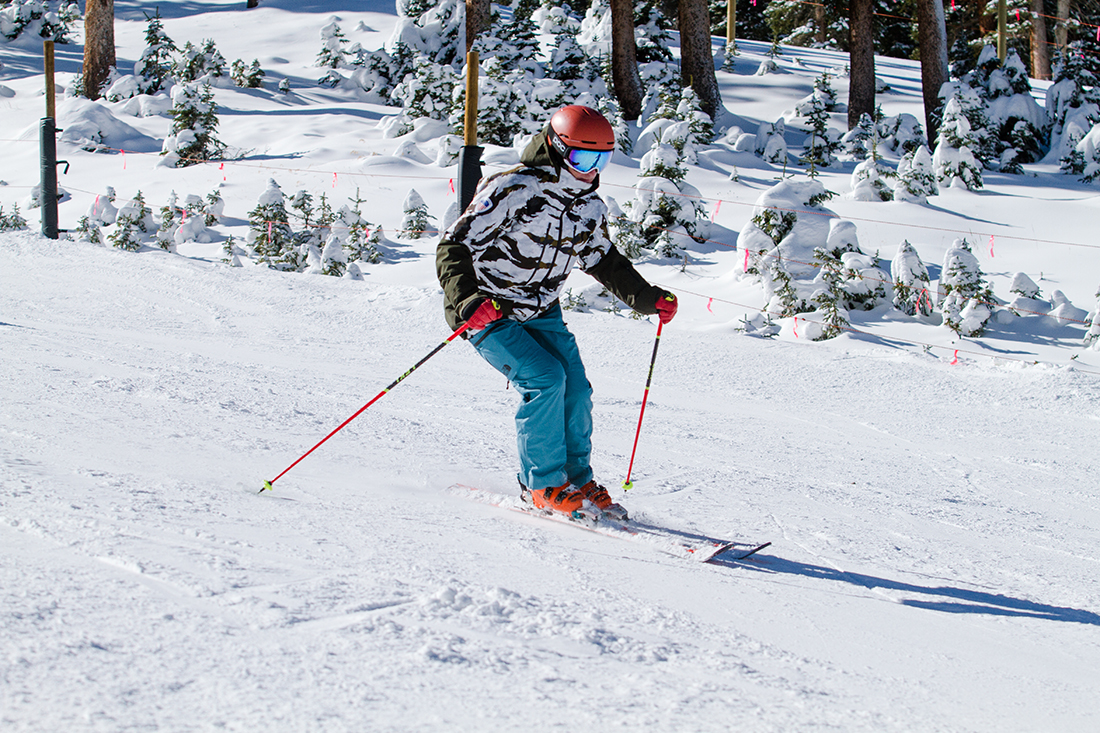32 Degrees: Off-Piste Edge Control
This article by PSIA Alpine Team member Troy Walsh appeared in the Winter 2023 issue of 32 Degrees. You can read the entire magazine right here.
Rare are the times we can use the words “always” and “never” when teaching skiing. Skiers can blend and apply PSIA’s Alpine Skiing Fundamentals (see the sidebar below) in lots of ways to achieve the desired outcome. Being able to explore and blend these fundamentals allows you and your students to use the mountain as a playground for new and interesting adventures.
Alpine Skiing Fundamentals
- Control the relationship of the center of mass to the base of support to direct pressure along the length of the skis.
- Control pressure from ski to ski and direct pressure toward the outside ski.
- Control edge angles through a combination of inclination and angulation.
- Control the skis’ rotation with leg rotation, separate from the upper body.
- Regulate the magnitude of pressure created through ski/snow interaction.
In off-piste terrain and bumps, one of the first challenges skiers face is that the feedback they receive from their skis differs from what they experience on machine-groomed terrain. That’s okay!
To help your students process the feedback, it’s a good idea to ask them these five questions:
- Are the skis moving through the snow in a smooth arc?
- Were you able to maintain balance?
- Were you able to keep your skis on the ground?
- Were you able to leave the ground when/if you wanted to?
- Were you standing more on the outside ski than inside ski?
Those able to answer yes to a couple of these are probably doing just fine (and your movement analysis can confirm that). And for those who mostly answer no? Well, that’s where your skill as an instructor comes in.
When skiing natural terrain, it’s tempting to try for more grip than necessary. But rather than seek grip through higher edge angles, I find that lower edge angles – what I like to think of as “having access to the bottom of the ski” – helps me smooth out the ride. A particularly relevant alpine skiing fundamental is the one that calls on skiers to “control edge angles through a combination of inclination and angulation.”
Bumps or other challenging terrain often provide all the edge angle you need. Adding more edge to the ski can make the ski run off in a tangent, which frustratingly disrupts the flow of the run. Here’s an activity you can use to help students release and engage the edges of their skis in variable terrain.
Basic Leaper
In a basic leaper – typically performed in medium- or long-radius turns, the skier leaps off one set of edges and lands on the other set of edges, with the edge-change movements occurring in the air. The skier continues to develop the new turn as the skis re-engage with the snow. You may ask yourself how this movement combines inclination and angulation to control edge angles. The leap promotes inclination at the top of the turn. To shape the turn, maintain balance, and direct pressure to the outside ski, the skier begins to tip the legs more than the body, and the shoulders and pelvis become more level to the slope, creating angulation. Remember, trying to gain too much edge angle in off-piste can be counterproductive if you’re looking for more flow on the run.
With students, first try this activity on groomed terrain with a similar pitch to the off-piste terrain they’re looking to conquer. In a corridor about 1.5 groomer widths wide, have skiers make a series of turns in which they leap at turn transition. It doesn’t matter how high the leap is. More importantly, are the skis (tips and tails) coming off the ground equally? Did the edge change happen in the air? Did the skier take off and land in balance? Did the skier guide the skis through the arc after the leap? Answering yes to any of these questions is a good start.
I find this activity to be most helpful when I focus on the moment just before the leap and when landing from the leap. When done correctly, my skis take off from a slightly-edged ski (old turn edges) and land on a slightly edged ski (new turn edges).
After a couple of runs doing this activity on groomed terrain, venture to some smaller bumps or ungroomed snow. Remember that the “leap” doesn’t need to be very big; in fact, the leap may not even occur. Just being in a place that the skier can leap is a success.
As you and your students get in some mileage in the natural terrain, reflect on the movements that allowed for successfully leaping on the groomers. Focus on how the skis move through the snow and the rhythm established when flexing, extending, tipping, and turning – all connected in one seamless run. Hopefully, with some newfound skills and a better understanding of fundamentals, your students will discover more of the mountain is now available for them to explore.
__
Troy Walsh is a member of the PSIA-AASI National Team, based out of Sunday River, Maine. He is an alpine assessor in PSIA-AASI’s Eastern region.







